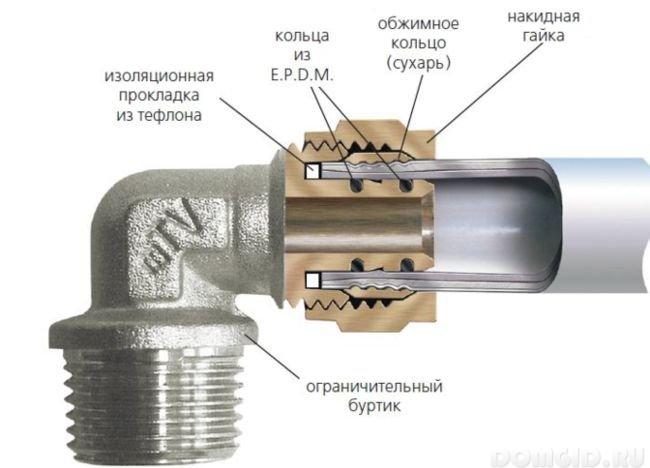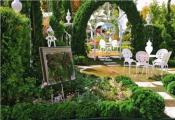Search
Login
Metal-plastic pipes, what is it, where a metal-plastic pipe is used, useful tips
Metal-plastic products owe their wide distribution to the unique combination of the positive qualities that plastic and metal possess in them. In order to make a competent choice of the appropriate type of pipe to solve a specific problem, you should dwell on the characteristics of metal-plastic products and recall their advantages once again.
Content
- Qualitative characteristics, disadvantages and advantages
- Pipe material and construction
- How to choose the right
- Area of \u200b\u200busevideo
- Technical Details
- How to decrypt marking
- How is the connection of plastic pipes video
Qualitative characteristics, disadvantages and advantages

Metal-plastic products owe their positive qualities to each material used in their manufacture, the advantages of pipes are:
- in resistance to corrosion processes,
- in resistance to overgrowth and siltation,
- environmental friendliness
- a throughput rate that is almost 1.3 times higher than that of conventional metal pipes,
- resistance to active chemicals
- strength, reliability, durability - their service life can be about 50 years,
- high ductility and low weight
- low thermal conductivity
- simplicity of assembly - it is not at all difficult to do the installation of metal-plastic pipes with your own hands, while special equipment, for example - a pipe bender or a welding machine will not be required,
- the ability to install the system inside the walls,
- aesthetics of appearance, painting of such products is not needed.
Of the disadvantages of plastic pipes, it will be necessary to note the following:
- Since the linear expansion coefficients of plastic and metal are different, the result of a frequent temperature drop can lead to leakage at the joints, they usually occur as a result of weakening of these points.
- To prevent the situation, experts recommend laying pipes with a small margin, and in the places of bends - equip compensation loops.
- The bending of pipes made of metal-plastic is carried out using a spring, although by their nature the pipes are quite plastic, but they can suffer from multiple configuration changes. Moreover, it is recommended to bend the pipe in certain radii.
- To bend the pipes, you can use a special spring, to do it yourself, you must insert the spring into the pipe, fill it with sand. In any case, the step of bends on the pipe should not exceed 50 cm. Metal-plastic products cannot be twisted about their axis.
- In addition, metal-plastic pipes, the prices of which are about two times higher than, for example, polypropylene pipes, have lower strength characteristics. The fittings used during installation are also expensive.
Pipe material and construction

By design, the metal-plastic pipe consists of several layers. Internal, which is in contact with the carrier, it is made of polyethylene, designed to give strength. As the second - aluminum foil is used, the structure of this material allows its use as a stabilizing and preventing diffusion of oxygen. The layers are connected with special glue, the edges of the foil are connected by laser welding. The finishing plastic layer has a beautiful white color.

Such an original structure of pipes allowed to significantly extend their service life.
Each of the layers of such a product performs certain tasks:
- cross-linked polyethylene of the inner layer - has an extremely smooth surface that prevents the deposition of salts and scale on the walls,
- both layers of the polymeric material help to reduce thermal conductivity, reduce the likelihood of condensation on the surface,
- prevent the formation of galvanic pairs: aluminum pipe core with brass or steel pipe elements.

Since the wall thickness is insignificant, for example, for pipes with a diameter of 16 mm it is only 2 mm, the weight of a running meter of such a product is only 115 g.
How to choose the right
In specialized stores of building materials, you can buy plastic pipes with a diameter of 16-63 mm. The most popular are products with a diameter of 16, 20, 26 mm. If the wiring in the house is quite extensive, then pipes with a diameter of 32 mm or 40 mm can be used.

To create a water supply system for an ordinary apartment, you can use a diameter of 16 mm or 20 mm. They are conveniently assembled together - for the main wiring use products of a larger diameter, for taps (to faucets, a dishwasher or washing machine, a shower) a pipe with a diameter of a smaller one is quite suitable. The benefit is that fittings for metal pipes with a diameter of 16 mm have a lower cost. In the event that the pressure in the water supply system is normal, then pipes with a diameter of 16 mm can be used in it without any damage to the quality of the water supply.
Plastic pipes go on sale in bays, the length of the bay can be from 50 m to 200 m.
Area of \u200b\u200buse
Plastic pipes are often used:
- for creating plumbing systems in private houses and apartments of high-rise buildings,
- due to the absence of harmful impurities in the plastic coating of the pipes, they can be used to supply drinking water,
- gas pipelines and various types of fluid delivery systems are built from them in all industries, in the conditions of agricultural enterprises and transport
- with their help, compressed air is successfully supplied,
- they are used to create air conditioning systems,
- they are used to design sheaths for shielding and protecting electrical power cables.

There are also some restrictions on the use of plastic pipes:
- from them it is impossible to construct heating systems in which elevator units will be included,
- they cannot be used in rooms with high fire hazard (class G),
- you can not use such pipes in systems with a working fluid pressure exceeding 10 bar,
- it is forbidden to mount metal-plastic systems located near heat sources whose surface temperature exceeds 150C.
Do not use metal-plastic pipes in the construction of fire water supply systems, as well as overflow, signal or expansion pipes.
Technical Details
One of the important quality indicators is their ability to withstand certain temperatures and pressures. For metal-plastic products, such indicators are quite high, at optimal operating temperatures ranging from 0 to + 95 ° C, the pressure in the pipeline can be about 10 bar.

With increasing pressure, temperature indicators should decrease, for example, at a pressure in the pipe of 25 bar, the temperature of the carrier should not exceed + 25C. The pipeline can withstand, without collapsing, a short-term increase in the temperature of the carrier to + 110C. If the pipeline will operate at the maximum permissible temperatures, then the pressure in it should not exceed the mark of 10 bar. The maximum allowable for a metal-plastic pipe at a temperature of + 20 ° C is a pressure of 94 bar.
How to decrypt marking
Marking on the pipes is applied in order to convey to the consumer the maximum of useful information about these products and the optimal conditions for their operation. There may be some changes in the order of information in the marking code, depending on the manufacturer, but in most cases it looks like this:
- First comes the name of the manufacturer.
- Next - there is information about the features of the product: material, method of its crosslinking, protection from ultraviolet radiation, etc.
- The symbols PE-X, PE-R, PP-R indicate that the material for the manufacture of pipes was cross-linked polyethylene, polyethylene or polypropylene.
- Information on how crosslinking was performed is indicated by the symbols: a - pyroxide method, b - using silane, c - directional electrons, d - azo compound of the molecules.
- The diameter of the products and the value of the wall thickness of the pipes are indicated in mm, it is very rare that the diameter of metal-plastic pipes (from 20 to 1200 mm) is indicated in inches.
- The following data is entered into the code on the nominal pressure (in bars) at the temperature of the medium + 20 ° C.
- Then it is indicated which medium can be transported using these pipes, for example, it is forbidden to move chemically active substances in water pipes.
- The last numbers in the marking indicate the time of manufacture of the pipes and the batch number.

Experts recommend that when assembling water supply or heating systems, leave the opportunity to read the markings - if necessary, this will allow you to accurately determine which pipes were used during assembly.
How is the connection of plastic pipes

Fittings are used as connecting elements during the installation of metal-plastic pipes. It is advisable to purchase them complete with pipes, i.e. the pipes themselves and the connecting elements for them must be from the same manufacturer, this will save time on assembly and reduce the complexity of installation work. The installation technology is quite simple, expensive equipment and tools will not be required during its implementation.

If compression fittings are used during installation, the press-fit will be done by tightening the union nut. If press fittings are used - by compressing the outer sleeve, using special pliers for metal-plastic pipes, you can buy them at construction supermarkets.

Press jaws can be used with a cordless press or with an electric press unit. If pipes of small diameter (from 14 mm to 20 mm) are used, then manual press machines can be used. Crimp fittings are connected using wrenches. It should be noted that it is impossible to disconnect the press connection, with a threaded connection, the nut can be expanded, but the insert will still be connected to the pipe.





